![]()
![]()
![]()
Use LEFT and RIGHT arrow keys to navigate between flashcards;
Use UP and DOWN arrow keys to flip the card;
H to show hint;
A reads text to speech;
38 Cards in this Set
- Front
- Back
|
Classification of genetic disorders/diseases |
Monogenic - Mendelian disorders |
|
|
Monogenic disorders
|
Most of genetic disorders are due to “single gene mutation” and “chromosomal aberrations” Mendelian type of inheritance. (1 gene) About 5000 diseases Autosomal dominant |
|
|
Autosomal dominant / recessive |
"Autosomal" means that the gene in question is located on one of the numbered, or non-sex, chromosomes. "Dominant" means that a single copy of the disease-associated mutation is enough to cause the disease. "Recessive" disorder need two copies of the mutation are needed to cause the disease |
|
|
X-linked |
Single gene disorders that reflect the presence of defective genes on the X chromosome
Either recessive or dominant
|
|
|
Simple recessive |
an individual receives defective genes from each of its parents.
aa – shows the defect (homozygoys recessive ) |
|
|
various types of mating that can arise |
Aa x Aa --- ¼ AA (normal) : ½ Aa (normal) : ¼ aa (shows the defect)
(mating not possible if aa is lethal) |
|
|
carriers
|
Parents with heterozygous Aa
(defective gene causes some biological process to fail) |
|
|
Metabolism |
chemical or physical changes undergone by substances in a biological system |
|
|
metabolic disease |
any disease originating in the chemical reactions / metabolism of individuality.
|
|
|
Inborn errors of metabolism |
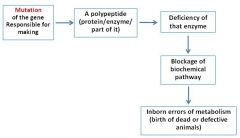
|
|
|
Example of IEM |
Citrullinaemia in Holstein-Friesian calves
Calf appears normal at birth - depression within a few hours - tongue protrusion, and unsteady gait next day - froth in the mouth - pressing the head against solid objects - Calf collapse and die by 3-5 days - ammonia toxicity |
|
|
Citrullinaemia |
Ammonia accumulation in the body due to lack of the enzyme, argininosuccinate synthetase (ASS) - converting citrulline to argininosuccinate. A single base-substitution T for C in the 86th triplet code (CGA=arginine) of the gene;
|
|
|
Genotype and Phenotype |
In this example, say:
|
|
|
nature of point mutation |
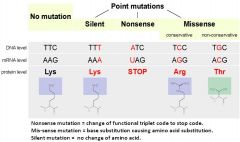
|
|
|
Sex-limited inheritance |
Phenotype associated with the mutation (female feathering in male) can be seen only in males |
|
|
example of sex-limited inheritance |

|
|
|
Sex-linked inheritance |
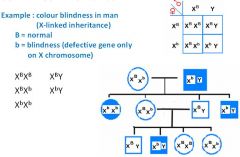
|
|
|
Holandric inheritance |
Some genes carried on the Y chromosome and are passed directly from father to son (Y-linked inheritance)
Hairy ear in man - only in man |
|
|
Difference between Sex-limited and Sex-linked |
Sex-limited or sex-influenced traits are autosomal traits that are influenced by sex.
Sex-linked traits are expressed by genes carried on the sex chromosomes. |
|
|
Management of Genetic Defects |
Identify - genetic origin or nutritional deficiencies or injury. determine if siblings or other descendants also display the condition - to compare the observed symptoms with other genetic defects with similar physical characteristics. Check if other producers have observed the same problem
|
|
|
Management of Genetic Defects - Testing |
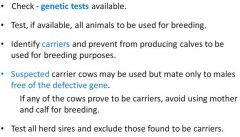
|
|
|
Genetic defects |
Syndactyly / Polydactyly - one hoof or many hoofs or fingers
Albinos - (Albinism)
|
|
|
Chromosomal aberrations |
During mitosis, meiosis or fertilization. |
|
|
Types of Chromosomal aberrations |
Monosomy – lack of a chromosome
Trisomy - the presence of 3 X chromosomes (XXX) - caused by Non-disjunction during miosis
XXX individuals are less abnormal than XO individuals - often fertile |
|
|
Non-disjunction |
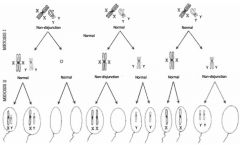
|
|
|
Trisomy |
an extra copy of ONE chromosome in an egg or sperm cell. As a result, after fertilization the fetus has 47 chromosomes instead of the usual 46. An example of this is Downs Syndrome, in which there is an extra chromosome 21 |
|
|
Trisomy karyotype |
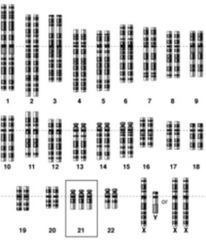
|
|
|
Triploidy |
the fetus has an entire extra set of chromosomes -- so it has 69 chromosomes instead of the usual 46.
|
|
|
Triploidy karyotype |

|
|
|
__somy |
all possible combinations of abnormal sperms and egg |
|
|
Abnormal Chromosome Structures
Translocation |
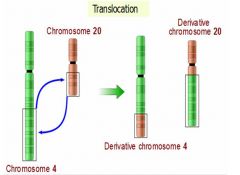
|
|
|
Abnormal Chromosome Structures
Single chromosome mutations |
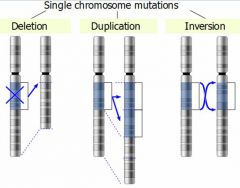
|
|
|
Abnormal Chromosome Structures
Insertion |

|
|
|
Freemartin |
XX/XY chimerism (freemartins have both XX and XY leucocytes)
Major effect seen on gonads of female
|
|
|
Freemartin symptoms |
Ovotestes – containing both ovarian and testicular tissue |
|
|
Intersex |
individuals having various mixtures of maleness and femaleness.
Hermaphrodite: synonymous with intersex |
|
|
Pseudo-hermaphrodite |
Male hermaphrodism - Animal has the chromosomes of a male, but external genitals are incompletely formed, or clearly female. Internally, testes may be normal, malformed, or absent.
|
|
|
Intersexuality |
Anything is possible in the realm of intersexuality |

